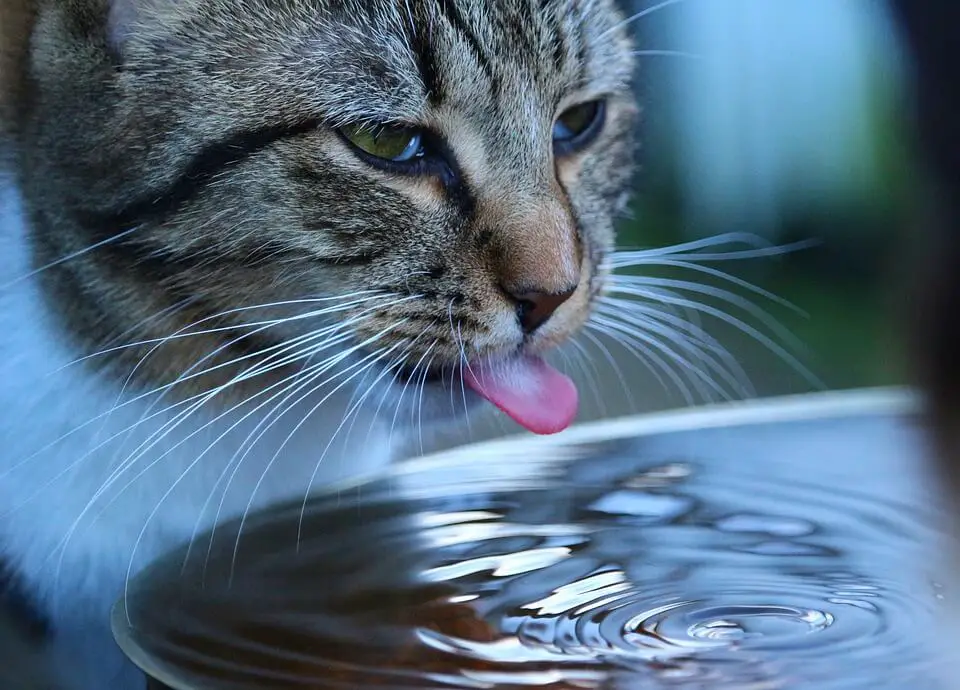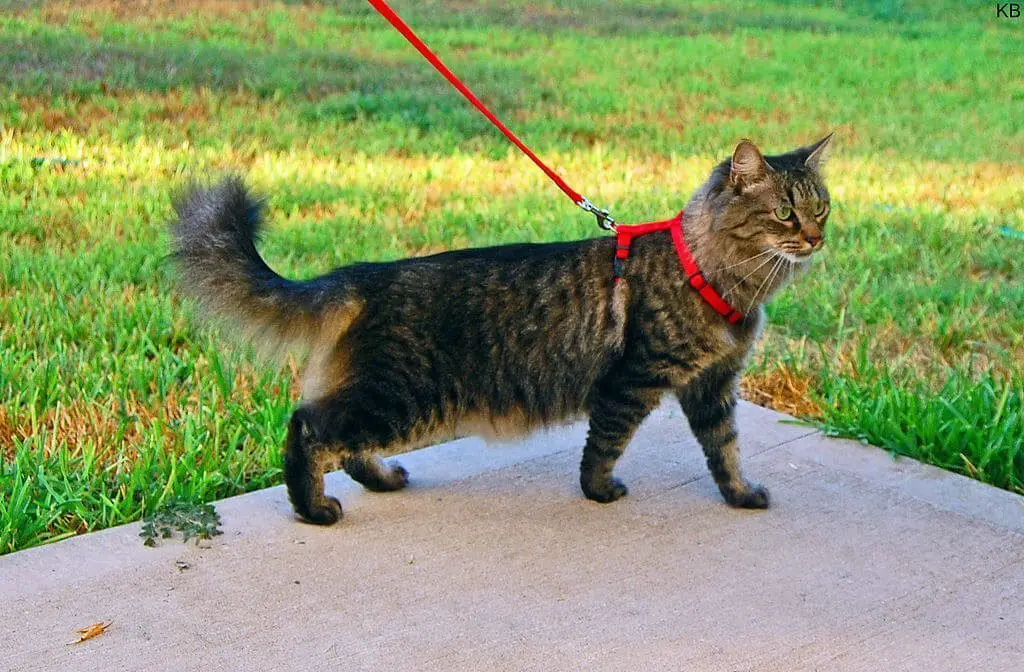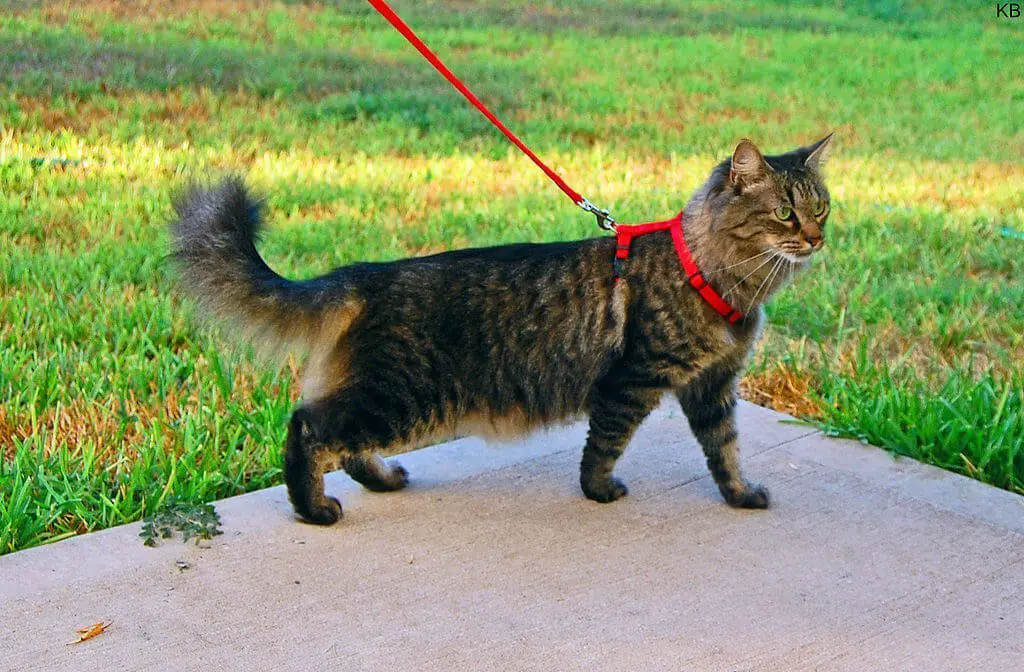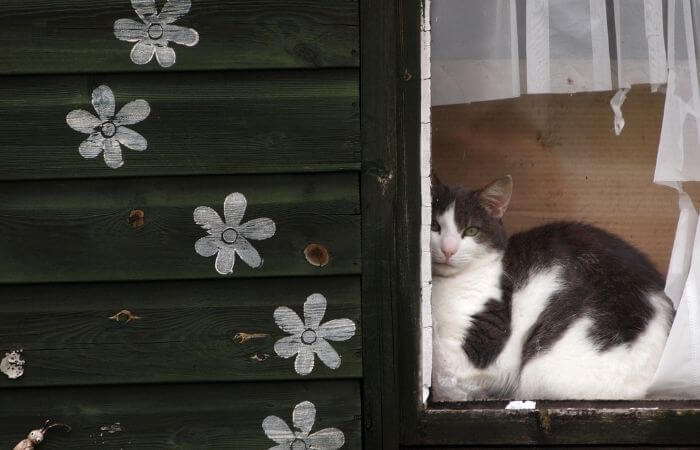Social media is full of beautiful pictures of dogs exploring the natural world with their owners, but did you know you can take your cat hiking too?
It may sound strange at first but many cats are adventurers at heart.
The enrichment and enjoyment your cat can gain from going exploring with you is huge.
Just like us, being active can be a great benefit for your beloved kitty’s health and wellness.
Going hiking with cats is becoming more and more popular but before you load up the car and head to the hiking trails, let’s first take a look at how you can make this a safe and enjoyable trip for all.

Not all cats will want to go hiking or enjoy it, the majority of cats will be fine with hiking as long as they have been trained and don’t become very nervous or stressed about new experiences.
Keep the temperament, nature and physical condition of your cat in mind when deciding whether to go hiking together or not.
Contents
What Cat Hiking Kit Will You Need?
Of course, you’re going to need to take some hiking gear with you to keep your cat safe and happy. Below is a list of the absolute essentials:
Cat Backpack
A cat backpack is a vital piece of kit, if you don’t have one or want to find out more about them check out our cat backpack page.
A cat backpack allows you to carry your cat when they become tired in a way that is convenient, comfortable and easy.

It is also useful to have on hand if you come across other wildlife or dogs on the hike as you can safely and securely remove your cat from the situation by placing them in the cat backpack.
Harness & Lead
The harness needs to fit properly and be comfortable for your cat to wear. It is very important that your cat has walked around in the harness previously and you’ve practised walking them on a lead before – read more about walking a cat on a lead here.
This kit is what keeps your cat close to you and out of danger so make sure they are properly attached and a good fit.
Food & Water
It’s tiring to hike and for a cat it can be exhausting.
Keep in mind that a cat doesn’t have the same energy levels as humans or dogs so don’t forget to pack treats and enough water.

It’s best not to let your cat drink water from puddles or streams as they can be full of bacteria and your cat is not used to it and could become sick.
Only offer your cat snacks during a hike as a full meal can cause cramping and even vomiting.
Poo Bags
Don’t forget poo bags so you can clean up after your cat on the hike and help keep the trails clean.
Sun Protection
Hairless cats and short-haired cats can become sunburnt so you may need to bring pet-friendly sun protection for them.
Collar (remember to attach ID tags)
Although you will be using a cat harness, it’s important you also have a cat collar with ID tags on your cat too. This is so if your cat does manage to sneak away from you, they can easily be returned once found.
It’s better to be safe than sorry.
Also make sure your cat is microchipped before heading out on an adventure.
Camera
Oh… and don’t forget your camera!
You’ll be able to get some great snaps of your bestie on an adventure (and Instagram will explode from the cuteness!).
Training Your Cat Before The Walk
To avoid throwing kitty in at the deep end, it is important that you do some training before you head out on a hike.

First of all, your cat should be comfortable walking with a harness and lead. Practicing walking around the garden or the local park is a good idea.
Always use a harness and a lead rather than a collar and a lead as your cat could easily slip out of the collar whereas harnesses are much more reliable.
With that said, it would be useful to have your cat trained to come to you when you call their name, just as a backup in case they manage to slip the harness or you accidentally drop the lead.
Plan, Plan, Plan
The more planned the hike is, the better.
Know the route you want to take, how long it is, the kind of terrain it involves.
Avoid trails that involve crossing water or obstacles.
If you are going to be out hiking for longer than a day and you plan to overnight somewhere, make sure the place accepts cats and be sure to pack everything you’d need for the period of time you’ll be away from home for.
Research the trail rules as some trails may not allow cats, it’s best to double check although rules regarding cats aren’t too common!
Deciding Where Ro Go Hiking
There will likely be many trail options for you to choose from.
Try to hike in an area that is quiet.

Choose a route that will suit your cat’s fitness level and age.
Kittens may be more energetic but this is only true in short bursts, they shouldn’t hike for long and it’s best not to allow them to jump or climb too far when they are young.
Also think about the walks you have done previously, try to walk a similar distance and if you are wanting to walk longer and further then build this up slowly over time.
Check the Weather & Rearrange if Necessary
Always check the weather before you head out on a hike with your cat, you don’t want to go if it’s too cold, too hot or raining.
Rearrange the hike for another time if there is a risk of extreme weather.
You don’t want your cat to dehydrate, suffer from heat stroke or become cold when you are out.
If it is likely to be cold then you may decide to take a coat for your cat with you too.
Walk in weather that will be comfortable for both you and your cat.
Also keep in mind how the sun can impact the skin of hairless or short-haired cats.
Before Heading Out into the Wilderness Make Sure Your Cats Vaccinations are Up-to-date
It’s a good idea to head to the vets beforehand so your cat can have a full health check and you can ensure all vaccinations are up to date.
When you are out hiking your cat will be exposed to different wildlife and there is a risk of picking up diseases and parasites so ensuring you are up to date with vaccines is a must.
Make sure you are up to date with flea treatments as well as tick and heartworm treatment too.
Tips When You’re Out Hiking
Once you’ve made it out to the trail it is important you take it slow, to ensure you both have a good time keep in mind our top tips:
Always Keep Your Cat on the Lead
The last thing you want to do is see your cat running off into the trees.

Although your cat may be very well behaved and walk by your side without a lead, it is easy for your cat to become distracted, intrigued or even scared by the potential encounters when out hiking so make sure you know how to calm down a scared cat in case anything happens.
There will be wildlife in the areas and even a squirrel in the tree may get your cat’s attention.
To keep your cat safe, it is best to keep a lead and harness on at all times however be aware that it is not good for your cat to always be wearing a harness as it limits their ability to groom themselves so plan in some harness free time in a safe place where you can be confident you won’t lose them.
That way you can always watch over your cat and make sure they are safe. It can also be helpful as your cat could try to eat something along the trail and you’ll quickly be able to stop him if you have him on a lead.
You May Need to Carry Your Cat at Times
When hiking you may come across other hikers with animals, or even wildlife, if this happens it is best to pick up your cat. Picking up your cat can reassure them that they are safe and out of danger.
You will also need to pick up your cat if they get tired, or if the trail becomes steep.
If your cat does become tired you can offer some food and water and then place them into your cat backpack to relax.
This is especially important if you want to cover larger distances as your cat will likely only be able to cover short distances at a time.
Take Breaks & Regularly Offer Water & Snacks
It is important to regularly stop to give your cat a chance to rest for a moment.
During these breaks offer your cat water and snacks as they will be using a lot of energy during the hike.
Your cat will not have the same capabilities as a dog or a human so walking a cat will be very different, don’t rush and keep an eye on your cat to make sure they aren’t struggling with the hike.
Most cats will be comfortable walking a mile or two but this can be built up over time if they enjoy the time outside.
Most important of all, have fun and be safe!
As an Amazon Associate I may earn a small fee from qualifying purchases at no extra cost to you. This helps us run the site, so thanks for your support!








Leave a Comment